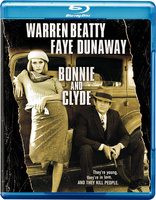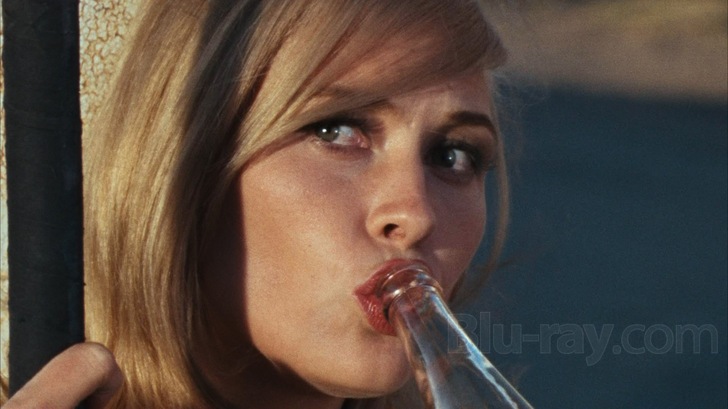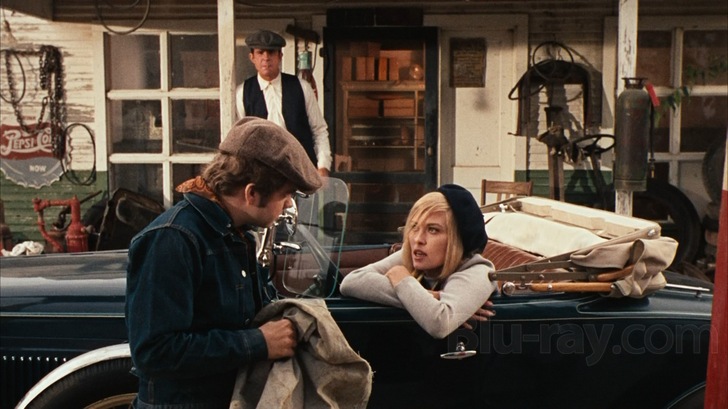Bonnie and Clyde Blu-ray Movie
HomeBonnie and Clyde Blu-ray Movie 
Warner Bros. | 1967 | 111 min | Rated R | Feb 02, 2010
Movie rating
8.1 | / 10 |
Blu-ray rating
| Users | 3.3 | |
| Reviewer | 4.0 | |
| Overall | 3.6 |
Overview
Bonnie and Clyde (1967)
Bored waitress Bonnie Parker falls in love with an ex-con named Clyde Barrow and together they start a violent crime spree through the country, stealing cars and robbing banks.
Starring: Warren Beatty, Faye Dunaway, Michael J. Pollard, Gene Hackman, Estelle ParsonsDirector: Arthur Penn
| Drama | 100% |
| Period | 32% |
| Romance | 23% |
| Biography | 20% |
| Crime | 16% |
| Heist | 9% |
Specifications
Video
Video codec: VC-1
Video resolution: 1080p
Aspect ratio: 1.78:1
Original aspect ratio: 1.85:1
Audio
English: Dolby Digital Mono (192 kbps)
Subtitles
English, English SDH, French, Spanish, Korean
Discs
25GB Blu-ray Disc
Single disc (1 BD)
Playback
Region free
Review
Rating summary
| Movie | 4.0 | |
| Video | 4.0 | |
| Audio | 3.0 | |
| Extras | 3.5 | |
| Overall | 4.0 |
Bonnie and Clyde Blu-ray Movie Review
Digibook-haters can finally own this classic in a standard Blu-ray keepcase.
Reviewed by Casey Broadwater February 22, 2010Think of Sam Peckinpah’s The Getaway, Terrance Malick’s Badlands, Oliver Stone’s Natural Born Killers, and even David Lynch’s Wild at Heart—each has a common antecedent in Bonnie and Clyde, the controversial 1967 crime caper that officially ushered in the era of New Hollywood with its unflinching violence and nonchalant frankness about sexuality. And as the archetypal “two lovers on the lam” story, it has a little bit of everything. It’s a game- changing mash-up of slapstick comedy and bullet-riddled corpses, an anti-authoritarian romp and an ode to naiveté, a take-the-money-and-run thriller and a languid Sunday drive through the American South of the Dust Bowl and Depression. Essentially, it’s a road movie that presents love as a literal and figurative journey, fraught with abstract emotional obstacles as well as extremely tangible police barricades. It’s a bloody farce, an impotent romance with bisexual overtones, a steal-from- the-rich hootenanny. Hollywood would never be the same.

Target practice with Bonnie and Clyde...
Loosely based on the exploits of Bonnie Parker and Clyde Barrow—two lovers and outlaws who held up banks and killed at least nine police officers during the “public enemy” era of the early 1930s—the film is more beholden to the essence of the couple’s mythic romance than to the actual facts of their guns-a’blazin’ escapades. Played by striking beauty Faye Dunaway, Bonnie is a bored waitress who hitches up with Warren Beatty’s Clyde when the young gangster tries to steal her mother’s car. As Bonnie seductively wraps her lips around the mouth of a cola bottle, Clyde shows her his gun—the ultimate phallic symbol—which she instinctively reaches out to touch. She’s clearly excited by the danger, and after Clyde robs a store just to prove he’s no faker, Bonnie tries to jump his bones in the car. Clyde has none of it and pushes her away. “I ain’t much of a loverboy,” he says, masking the fact that his other pistol doesn’t seem to function properly. Nevertheless, they fall into a kind of infatuation with one another that only balks when it comes to physical intimacy. This is the source of much of the film’s underlying tension, as Bonnie disparages Clyde’s “peculiar ideas of lovemaking, which is no lovemaking at all.” Eventually, the two recruit mechanic C.W. Moss (Michael J. Pollard) to join their merry band —as well as Clyde’s brother Buck (Gene Hackman) and Buck’s wife Blanche (Estelle Parsons)—and together they become known as the “Barrow Gang,” lauded and feared across four states as ruthless criminals. Inevitably, though, they’re smacked down by the long arm of the law.
When Bonnie and Clyde was released, New York Times film critic Bosley Crowther—a stodgy member of the cinematic old guard—called it “a cheap piece of bald-faced slapstick comedy that treats the hideous depredations of that sleazy, moronic pair as though they were as full of fun and frolic as the jazz-age cutups in Thoroughly Modern Millie.” Much of the early critical response was equally disparaging, but then the unexpected happened—critics began issuing redactions and writing up second opinions, eager to cast the film as an indicator of Hollywood’s rapidly changing aesthetic. Crowther, however, remained antagonistic toward Bonnie and Clyde, and was pushed out of his post at the Times—a bit unfairly, it seems— for being out of touch with the nascent anti-establishment film culture. Soon, the old gave way to the New Hollywood, a kind of bastard cousin to the auteur approach to filmmaking that had gained traction in Europe thanks to French New Wave directors like François Truffaut and Jean- Luc Godard. In fact, Bonnie and Clyde screenwriter Robert Benton was greatly influenced by New Wave cinema, and offered the film to Truffaut, who declined and made Fahrenheit 451 instead. (Godard was also approached, but he reputedly wanted to reset the film in Japan, which was a big no-go for the film’s investors.)
Given its notorious reputation, Bonnie and Clyde looks tame—even quaint—in retrospect, but there’s no denying the taboo-busting impact it had on the place of sexuality and violence in American filmmaking. Inspired by the casual acceptance of sexual themes in European cinema, Benton initially wrote Clyde as bisexual and included a ménage-a-trois in the script between Bonnie, Clyde, and C.W. Moss. Warren Beatty talked him out of it—it would be perhaps too sophisticated for American audiences—but there are still subtle hints throughout the film that this was the writer’s original intent. More bracing, though, is how Bonnie is unabashedly cast as a highly sexual being, a trait that Dunaway—smoldering here with eager eyes and pouting lips—has no trouble conveying. The chemistry between Bonnie and Clyde—and, by extension, Dunaway and Beatty—is complex, both magnetic and reserved. She’s like a dog straining against its leash, and he’s all bravado, making up for his limp equipment by posing for pictures with his massive machineguns every chance he can get.
Those guns go off too, and regularly. Early in the film a banker gets shot in the face at point-blank range, and director Arthur Penn refuses to cut away, showing the man slump against the window of Bonnie and Clyde’s getaway car, his face a bloody mess. The film was also one of the first to extensively use squibs—the small, fake blood- filled charges that make it look like actors have been shot—and the literally explosive finale shows a level of carnage that had been heretofore unseen in a mainstream American movie. At the same time, Bonnie and Clyde is tender and funny, silly as the Barrow Gang speeds through an escape in a fast-motion sequence that might as well be set to the Benny Hill theme song, and serene as the camera pans over dusty plains and tracks through fields filled with brittle stalks of corn. It’s a contradiction, and that’s what makes it a classic.
Bonnie and Clyde Blu-ray Movie, Video Quality 

This is the same disc that Warner Bros released back in March of 2008, with the same 1080p/VC- 1 encode, but since the studio did such an excellent job the first time around, no remastering is required. Bonnie and Clyde has been lovingly restored with minimal tweaking and filtering, and brought to Blu-ray with excellent-for-its-age clarity. Sure, when compared to more modern productions, the image is softer and less resolute, but this high-definition transfer presents a tremendous upgrade from previous DVD releases of the film, with finer detail and better definition throughout. The film's dusty, southwestern Technicolor palette benefits as well, with warm and sumptuous skin tones, rich browns, weathered greens, soft blue skies, and Bonnie's luscious red lips. Black levels plumb the depths, shadow delineation is trouble-free, and contrast is tight but natural, giving the image a strong sense of presence. You may wonder why the picnic scene with Bonnie's mother looks so hazy and indistinct compared to the rest of the film, but this is because cinematographer Burnett Guffrey placed a mesh screen over the lens after director Arthur Penn requested he make the sequence look dreamy and diffused. Purists will happy to note that the film's grain structure is intact, and the print has been cleaned up wonderfully, with only the occasional white speck, and no tears, stains, or hairs. Likewise, the transfer is technically sound, and free of any over compression-related foul-ups.
Bonnie and Clyde Blu-ray Movie, Audio Quality 

While the film's transfer is solid, I do wish that Warner had re-pressed this disc with a lossless audio track. Just because the film was originally mixed in mono doesn't mean it wouldn't benefit from high definition audio. I am glad, however, that the studio didn't feel obliged to somehow separate the monaural audio elements into a forced 5.1 mix. So, I'm definitely somewhat ambivalent about the film's Dolby Digital 1.0 track. On one hand, it sounds true to source—dialogue is crisp and free of muffling or dropouts, the sound effects are expectedly dated but completely suitable, and the twangy banjo music, while a little brash and treble-heavy at times, has more than amble presence. On the other hand, I would love to hear what the film would sound like if Warner paid just as much attention to the audio as they did to the visuals. Still, even though it's lossy, this Dolby Digital track shouldn't detract from anyone's enjoyment of the film.
Bonnie and Clyde Blu-ray Movie, Special Features and Extras 

Love and Death: The Story of Bonnie and Clyde (SD, 43:15)
This History Channel documentary has nothing to do with the film and focuses exclusively on the
real-life tale of Bonnie and Clyde, complete with vintage newsreel footage, period accounts, and
interviews with a variety of historians, authors, and even Clyde's sister. The production values are
definitely dated—this looks like it was made in perhaps the early 1990s—but the information is
solid. Well worth watching.
Revolution! The Making of Bonnie and Clyde (SD, 1:05:00)
Directed by famed bonus features documentarian Laurent Bouzereau, this three-part feature
includes interviews with director Arthur Penn, screenwriter Robert Benton, and filmmaker Curtis
Hanson, along with all of the film's principal actors. Bonnie and Clyde's Gang is about the
genesis of the project and the screenplay's French New Wave influences, The Reality and the
Myth of Bonnie and Clyde covers the style of the film and its hodgepodge crew of New
Hollywood upstarts and Old Hollywood veterans, and Releasing Bonnie and Clyde follows
the production of the film through its final cut and controversial release. Fans should expect a
wealth of information.
Deleted Scenes (SD, 5:28 total)
Two scenes are included—The Road to Mineola is about the gang discussing the next
day's robbery at a diner, and Outlaws features Bonnie singing "We're in the Money" in
front of a mirror while C.W. watches from the tub, obviously turned on. Here's what the disc says
about these excised segments: "The following scenes were deleted from Bonnie and Clyde prior to
its 1967 theatrical release. Unfortunately, the audio for these scenes could not be located and is
presumed lost. The dialogue intended for these scenes is available with subtitles, sourced from
the film's original shooting script."
Warren Beatty Wardrobe Tests (SD, 7:41)
See Beatty walk around on film in a variety of period get-ups.
Trailers (SD, 4:11 total)
Includes the teaser trailer and the theatrical trailer.
Bonnie and Clyde Blu-ray Movie, Overall Score and Recommendation 

I really don't understand all the virulent hate for Warner's digibook releases, but if you've been holding out for the studio to release Bonnie and Clyde in the standard Blu-ray keep-case, your wait is over. No changes have been made to the actual disc—though I would've liked to have seen the addition of a lossless audio track—so if you've yet to purchase this influential film, the choice is yours as to whether you want the classy digibook or the run-of-the-mill, fits-on-the-shelf- with-the-rest-of-your-collection standard-issue case. Recommended.
Similar titles
Similar titles you might also like

Ain't Them Bodies Saints
2013

Live by Night
2016

Thieves Like Us
1974

Boxcar Bertha
1972

The Petrified Forest
1936

The Thomas Crown Affair
Reissue
1968

The Getaway
1972

They Live by Night
1948

Dog Day Afternoon
40th Anniversary Edition
1975

The Pay-Off
Losing Game
1930

The Assassination of Jesse James by the Coward Robert Ford
2007

Once Upon a Time in America
Extended Director's Cut
1984

Days of Heaven 4K
1978

Moonrise Kingdom
2012

In Cold Blood
1967

Little Caesar
1931

The Sting
1973

More
1969

The Irishman
2019

Boardwalk Empire: The Complete First Season
2010
